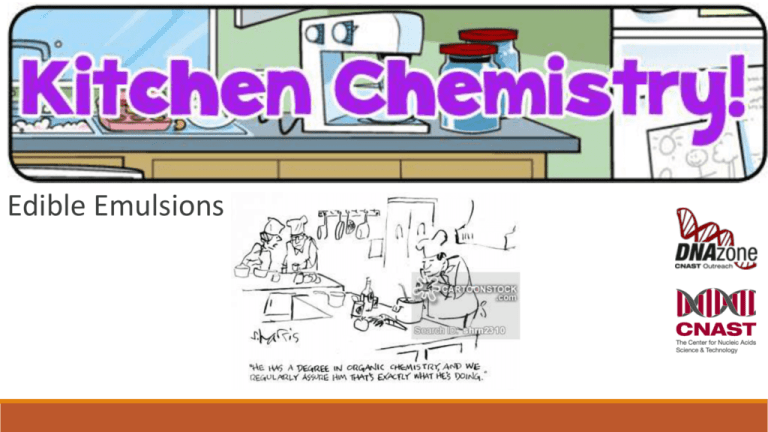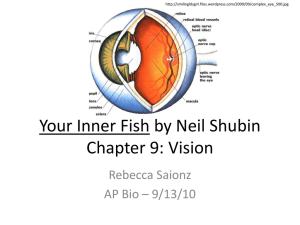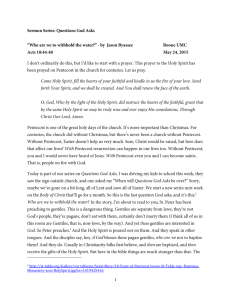Document
advertisement

Edible Emulsions “Water and oil don’t mix.” “Water and oil don’t mix” – at a microscopic level Water is polar. Oil often contains one polar end and one non-polar end. It is favorable to organize the molecules such that the polar water molecules are interacting with the polar ends of the oil, and not the non-polar ends. Oil and its family are essential components of life Biological system ◦ Lipid bilayer Cellular membrane ◦ Blood-brain barrier Everyday tools ◦ Detergent/cleaning tools ◦ Energy/fuel source ◦ cooking How does detergent/soap remove dirt and oil from clothing/skin? As detergent is applied, an emulsion of oil (or other nonpolar organic compounds) and water is formed. The hydrophobic ends in detergent trap the nonpolar compounds inside. The outside of detergent miscelles is hydrophilic; this along with other hydrophilic dirts can be washed off with water. Food and other everyday examples of emulsions Dispersed phase (droplets, bubbles, particles) Continuous phase Gas Liquid Solid Gas Gas/gas mixture (air) Liquid aerosol (deodorant spray, vegetable oil spray, fog/clouds, sneeze) Solid aerosol (powder fire extinguisher, smoke, asthma inhaler) Liquid Foam (meringue, whipped cream, soap foam) Emulsion (mayonnaise, butter, vinaigrette) Suspension (fruit juice, drinking chocolate, milk, paint, tooth paste) Solid Solid foam (bread, foam rubber, pumice) Gel (jelly, cheese, boiled egg, meat, vegetable- and fruit flesh) Solid suspension (coloured plastic, granite) “Melting” gum with chocolate!? How does it work? Polyene – the basic component of the gum base Lecithin in chocolate Break down by saliva Polyene Metabolism Chocolate Chantilly – How does it work?!?! Main ingredients of each component Chocolate Bar Lecithin (Amphiphilic, i.e. contains both polar (hydrophilic) and nonpolar (hydrophobic) regions) Juice Water (Polar) Citric Acid (Polar/ionic) Air molecules (N2, O2) Chocolate Chantilly – the procedure Melt chocolate/juice mixture in high temperature The mixture is still heterogeneous, i.e. compounds within are not well mixed. Inside the bowl: chemical compounds are not mixed. When the mixture is mixed thoroughly, lecithins aggregate due to hydrophobic interaction. Since air molecules (e.g. N2, O2) are non-polar, they are trapped within the hydrophobic sphere formed by lecithins. As a result, bubble forms After thorough mixing, the gas molecules are released and the bubbles disappear. The hydrophilic ends of lecithin form around water and citric acid molecules. Chocolate Chantilly is ready!! Your everyday sweeteners Sucrose Aspartame Sucralose What are the factors in determining solubility? Temperature Higher temperature increases solubility, and vice versa. Solvent More polar solvents, such as water, dissolve the polar sucrose better. Less polar solvents, such as acetone (nail polishing), dissolves sucrose not as efficiently. Functional groups on the molecule Different functional groups on a molecule can affect the polarity, and therefore the solubility. Sucrose Sucralose Impact in the Biological System Nucleic acid and protein folding due to hydrophobic/ hydrophilic effects – their structures have significant contributions to their functions! O2 gas can diffuse readily into cells without help. Metabolism of Amphetamine, a medicinal compound targeting the central nervous system. As shown in the diagram, more hydrophilic groups are added to the parent compound during metabolism in order to facilitate excretion of the drug from the body. References http://cdn.shopify.com/s/files/1/0387/2401/products/bar-solid-dark_ade26d20-29bb-4e23-b425-f3e6439363b5_1024x1024.jpg?v=1404319914 http://www.chowstatic.com/assets/recipe_photos/29197_vegan_chocolate_mousse.jpg http://s3.amazonaws.com/rapgenius/Minute-Maid-Juice1.jpg http://images.fineartamerica.com/images-medium-large/nitrogen-molecule-dr-tim-evans.jpg http://upload.wikimedia.org/wikipedia/commons/e/e5/Citric_acid_structure.png http://images.cpcache.com/merchandise/514_400x400_NoPeel.jpg?region=name:FrontCenter,id:68913273,w:16 https://tnrtb.files.wordpress.com/2013/05/figure-1.jpg http://upload.wikimedia.org/wikipedia/commons/thumb/1/1a/Micelle_scheme2-en.svg/2000px-Micelle_scheme2-en.svg.png http://www.biologycorner.com/resources/membrane_transport_01.jpg http://www.bnl.gov/today/body_pics/2012/07/protein-fold-350px.jpg https://farm3.staticflickr.com/2821/11235182875_7567f5f052_m.jpg http://www.cgm.cnrs-gif.fr/IMG/jpg/figure1_bis.jpg http://www.bio.miami.edu/tom/courses/protected/MCB6/ch10/10-01corrected.jpg http://oliveoilexplorer.com/wp-content/uploads/2012/12/Olive-Oil.jpg http://cdn.wonderfulengineering.com/wp-content/uploads/2014/05/What-is-Petroleum-Engineering-6.jpg http://www.washinghands.net/images/dial-liquid-hand-soap.jpg http://www.minimus.biz/images/F08-0106700-1100bg.jpg http://www.savingeveryday.net/wp-content/uploads/2011/05/splenda.jpg http://www.webstaurantstore.com/images/products/extra_large/63359/351472.jpg http://www.funkidslive.com/wp-content/uploads/2012/08/Kitchen-Chemistry.jpg http://lowres.cartoonstock.com/food-drink-chemist-chemistry-organic_chemist-degree-qualification-shrn2310_low.jpg








